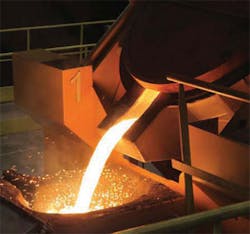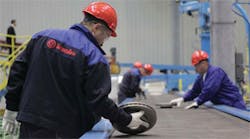Around the world one dream unites metalcasters, regardless of their experience or specialty: greenfield capacity. It's fine to add new melting or molding machinery, or to update cleaning and finishing systems, but there are limits to expansion and modernization. Cost and market opportunities are obvious constraints to many operators' potential, but plant infrastructure, inaccessibility, and local zoning rules are often overlooked as the limiting factors to a foundry's growth opportunities.
The experience of Brembo S.p.A. shows how much can be accomplished with a clean slate. Last summer the automotive brake specialist started up the second phase of its iron foundry in southwest Poland – an operation that first came online in 2003. It's a novelty for the European and North American metalcasting industries - high-volume, greenfield capacity - and it stands as a 90,000-m2 emblem of other foundries' fondest wishes. Brembo, headquartered in Bergamo, Italy, and operating in 15 countries, designs and manufactures automotive disc brakes around the world, for numerous manufacturers of cars, commercial vehicles and motorbikes. Brembo products carry various brand names, including Brembo, Breco, Bybre, Marchesini, Sabelt, and AP Racing.
Previously, Brembo operated aluminum foundries in Italy to produce brake calipers for motorcycles and passenger cars, but the investments in Dabrowa Grnicza, Poland, over the past decade have extended Brembo's industrial footprint. The new foundry operation was designed to integrate all phases of iron casting - from delivery of raw materials to shipping of finished products, which determined the selection of a centralized location to support Brembo's customers' requirements.
The manufacturer had a disc brake machining operation at the Polish site, so it recognized the opportunity to integrate its production there. The Dabrowa Grnicza location also offered low labor and utilities costs, a well-educated pool of workers, and a “growing industrial culture,” according to company sources.
In 2006 the foundry's first phase started operation, 70,000 metric tons/year, and expansion planning was underway soon.
A feasibility study was commissioned from Foundry Solutions & Design, indicating the expansion project's main KPIs (tonnage, production mix, man-hours/ ton, MWh/ton, etc), a draft layout of the foundry, and the main guidelines regarding the equipment selected. Once the feasibility study was approved, the “technical equipment specification” phase was initiated, followed by requests for quotation (RFQ), quotation evaluation (QEV), negotiation, purchasing, and final layout determination.
With the equipment purchase orders placed, a detailed engineering phase (foundations, mechanical interfaces between machineries and building, electric interfaces) followed, continuing even with construction underway. A team of Brembo and FS&D engineers managed all these steps jointly.
Cores are produced in an automated, cold-box operation. Robots collect finished cores for subsequent deburring, coating, and drying. At the exit side of the drying oven an operator collects and inspects the cores.
Planning a greenfield metalcasting operation means there are no precedents - so various alternative production processes must be considered. From the beginning of its Polish enterprise, Brembo studied the options available for melting (cupola versus electric furnaces), molding (vertical vs. horizontal), and coremaking (shell vs. cold-box). It settled on electric melting and horizontal molding, with cold-box coremaking.
“Once we verified the good results of the first foundry after four years of production,” a Brembo source explained, “it was decided to keep the same structure,” for the second-phase expansion. Duplicating those choices was seen as a way to optimize the previous installation, especially in terms of energy consumption, quality, process logistics, and plant safety.
The environmental aspect of the planning process deserves particular mention. Brembo noted that the operation's technical specifications were developed to minimize the number of stacks serving the plant, thereby to minimize the volume of dust to be handled. During the process design, the source noted, a particular effort was made to achieve closed-loop cooling circuits to minimize wastewater. Electricity consumption was achieved by choosing the largest (+90 kW) and highest-efficiency (IE2) motors possible, and with frequency converters wherever it was possible.
One appeal of a greenfield development is that there is no need to compromise. The equipment selections represent Brembo's ideal for metalcasting. Melting is done a series of coreless, mediumfrequency furnaces, chosen mainly due to the competitive cost of electricity in Poland, and the flexibility for batch production that induction melting allows. Another factor was the reduced environmental impact of induction melting.
As for molding, Brembo noted that its past experience indicated green-sand molding offered the most flexibility and high-volume capability for casting brake rotors.
Green sand is processed in large batch mixers, with a coal/clay premix and water. When the sand's desired mechanical profile is reached it is delivered to the horizontal molding machine. Once the new castings are poured, and cooled, the sand is conveyed by belt conveyors and bucket elevators back to storage silos, passing through continuous coolers, before it is retrieved for use in a later molding cycle
Cores are produced automatically in cold-box production cells. Robots collect finished cores for the subsequent, necessary operations: deburring, coating, and drying. At the exit side of the drying oven an operator inspects the cores and offloads them.
Gray iron pouring is carried out by a pressurized pouring furnace, with laser controls to maintain a constant level of liquid metal in the launder; cameras are used to check molten iron levels in the sprue cups as pouring proceeds. These devices will reset the signal for the stopper rods in order to adjust their position. Sensors maintain iron temperature through the pouring stream of every cycle, Brembo noted.
After cooling in the mold, castings are conveyed by belts or vibratory conveyors to a continuous shot blasting sequence. After blast cleaning the castings are sorted manually; returns are separated from the production process, and the semi-finished rotors are conveyed to the finishing lines.
The foundry's finishing operations consist of grinding, surface inspection, and ventilation, either manually or automatically, the manufacturer noted. Individual castings are placed on pallets or in bins (according to weight and dimensions) and then stored in an intermediate warehouse prior to machining. Machinists will collect the pallets and bins, and put the castings in line for automated machining on the inlet roller conveyor. Rotors are machined (turned, milled and drilled when necessary) and then delivered (automatically or manually) to painting lines. After painting, the finished castings are dried, and packed for delivery to customers.
Brembo's metalcasting operation has three distinct quality-control labs - for melting, for green sand, and for cores and finished castings. Available equipment includes an X-ray machine, hardness tester, wedge tester, sample polisher, electronic microscope, carbon/sulfur analyzer, and dimensional testing devices. The melting lab handles several chemical analyses, for example, spectrometry, thermography, solidification testing. The sand quality lab tests mechanical features like compactibility, green strength, wet tensile strength, active clay, permeability, and grain-size distribution, among others. The casting and core lab checks the structural and surface quality of those products.
Brembo sources also noted that the foundry contracts some offsite laboratories to perform specific tests.
Quality control starts well before production begins, and Brembo's Dabrowa Grnicza has simulation capability to test the pouring and cooling dynamics of any new pattern to be produced. Only after pouring and cooling have been tested and validated will production planning and pattern assembly begin.
Although the foundry does not employ rapid prototyping on-site, contractors may be engaged to produce RP cores, as necessary to address the cost or time constraints for building a new core box.
Prototypes casts are produced on the same lines as standard production, so the PPAP process is fast and effective, according to a foundry source.
Brembo's Polish project also illustrates the comparative ease of greenfield development. Following the feasibility study and related evaluations, the company's directors approved the construction plan in March 2010. Work began in June 2010, and production began in June 2011 - all according to schedule.
There were some construction delays due to the environmental conditions, according to Brembo. Though these details caused the schedule to be adjusted, the project team managed to adjust construction plans and reschedule some activities to proceed simultaneously, rather than in sequence, in order to meet the agreed start-up date. There were no significant changes in the design during construction.
The start-up process proceeded largely according to expectation. Metalcasting started with single-shift production in June 2011, and during the first two months of production various “major installation bugs” were addressed. Two-shift operation was underway during August and September 2011, leading to full (24-hour) production in October. The “line yield” has exceeded budgeted expectations since that time, Brembo reported.
To date, Brembo's Polish iron foundry has exceeded its production goals, and its performance goals. In addition to achieving ISO/TS 16949 and ISO 14001 certifications, it has earned Q1 recognition from Ford Motor Co. and the JLRQ standard from Jaguar Land Rover.
Brembo's Dabrowa Grnicza iron foundry in Poland is a testament to the manufacturer's clear vision and exceptional management program, and the operation stands as an inspiration to all metalcasters of what is possible when all options are available.












